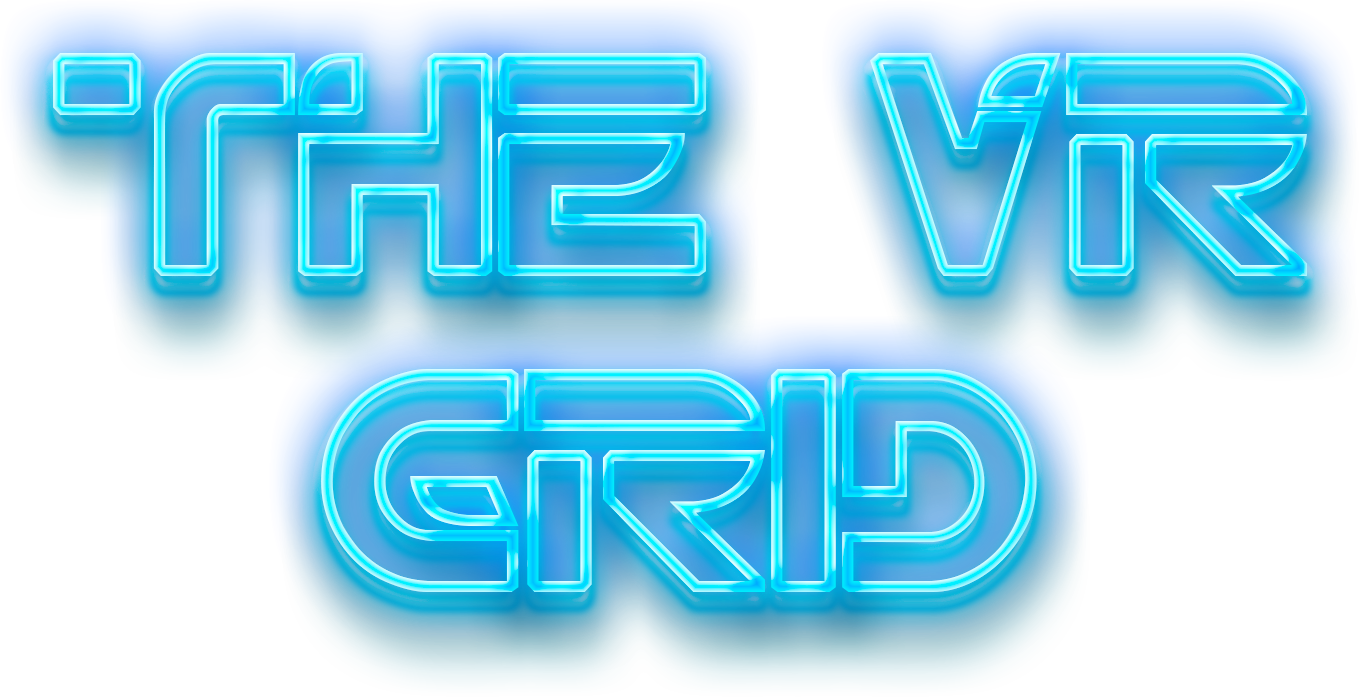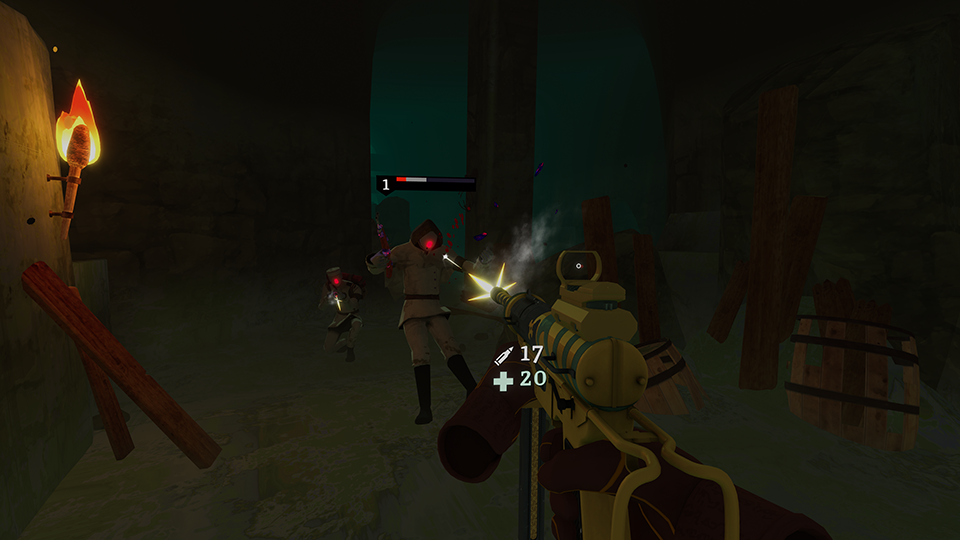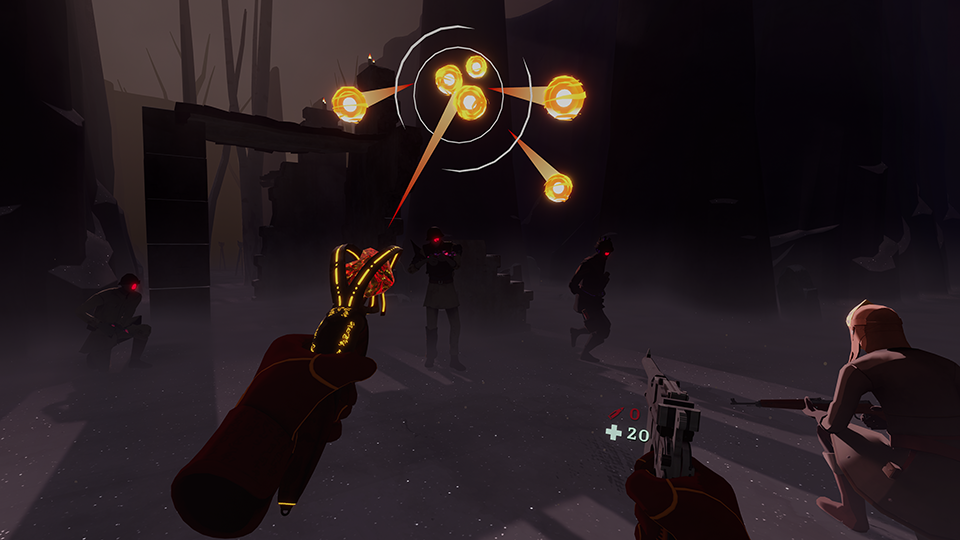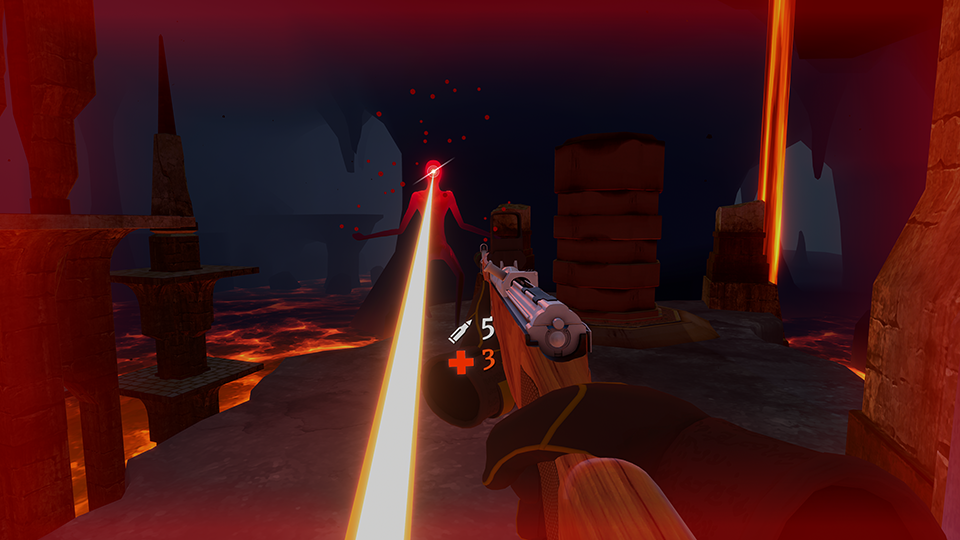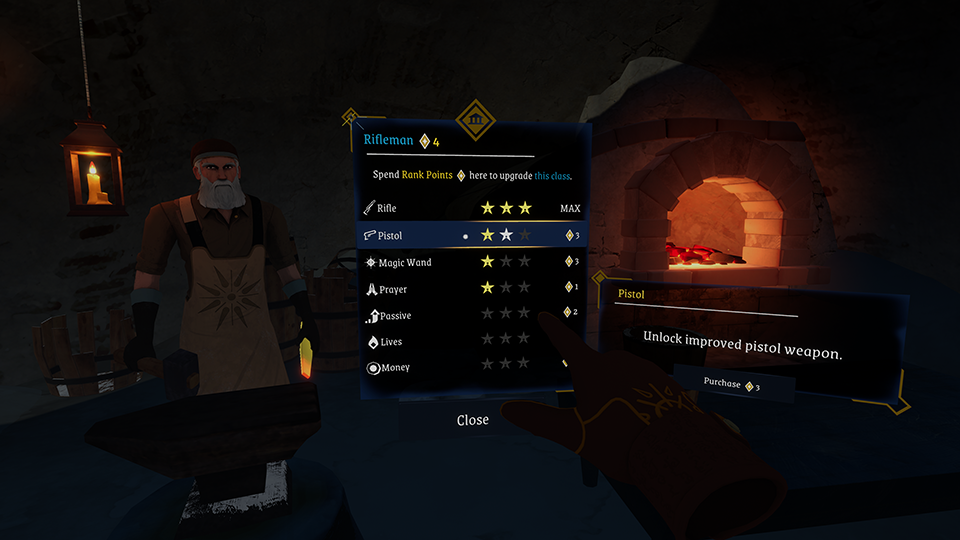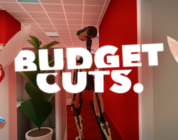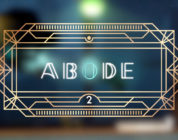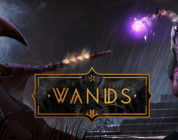Developer / Publisher – Funktronic Labs
Price – US $24.99 / CA $29.99 / EU €22.99 / UK £19.99
Release Date – February 16th, 2023
Input – 2 x Touch Controllers
Play Area – Seated, Standing, Roomscale
Store Links – Meta, Steam, PlayStation
Reviewed on – Quest 2
“The Light Brigade” is a Roguelight VR shooter that takes realistic world war weaponry, throws in magic powers, and sets you loose in procedurally generated worlds. Collect fallen souls and try not to throw your controllers in frustration as you realize just how much you suck at this game.
Okay, so I know there is a story here, something about the fall of the world and the rise of an evil obsidian order. You are part of the Light Brigade and must bring light back to the darkness… or something like that. Honestly, I found the whole narrative a bit inconsequential as I really just wanted to shoot things, and that I did a lot of…..oh yes.
Jumping into the gameplay side of things you should know that The Light Brigade is through and through a Rogue-lite…and not an easy one at that. As the default Rifleman class you and your trusty Enfield are sent on your way with little else but an “‘Atta boy!” and a few ammo clips, then through the teleportation gate, and off you go.
While the maps are procedurally generated, the game is broken into a specific order of biomes, each with their own look and design tendencies. Some may be fog-drenched forests, others may be floating sky levels, while others take place in castles and caves. It is within these specific biomes that maps will be procedurally generated, changing level design, elevations, enemy numbers and placements, as well as loot drop placements and the exit gate. Later levels, as well as your character class level will also have a significant effect on maps, altering what types of enemies you encounter, the behavior of said enemies and the rarity of loot you might find.
Borrowing more than a few ideas from the souls-like genre, killing enemies awards you with their fallen soul. Souls are collected throughout your run and are effectively your character-leveling XP…. if you can live long enough to deposit them at a….well, let’s call it a “soul kiosk”. Each given map is small to moderate in size and clearing a map of enemies will open up an exit gate. You will usually find soul kiosks at these gates, but not always, so staying along enough to clear a map with a gate can certainly amp up the level of risk-reward tension.
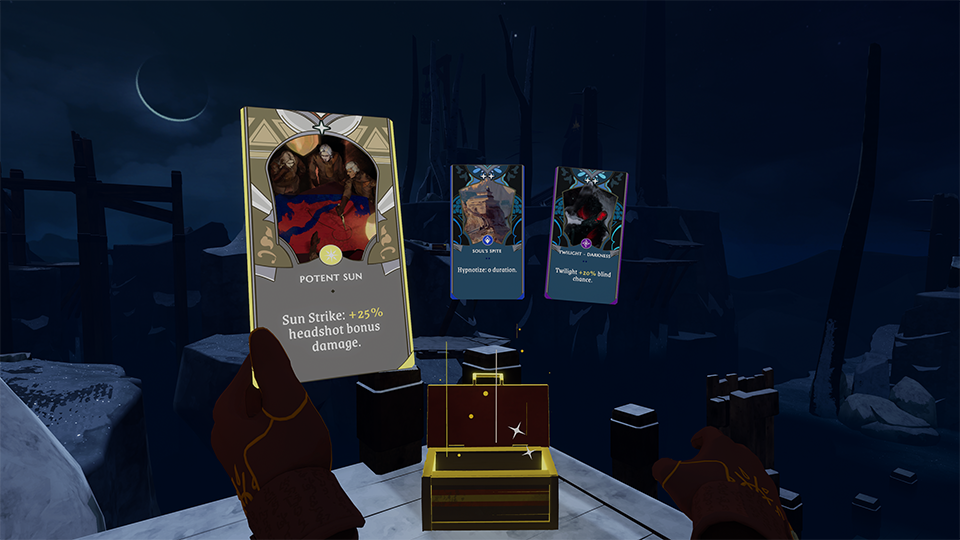
Choose your perk and try once again!
Death is not necessarily the end of a run as players are equipped with an extra life, with more being an upgrade option later on. In a very souls-like fashion, players are placed at the beginning of the map, weapons in hand and tasked with surviving until they reach their fallen corpse and praying to it in order to raise it back to life. If successful, the run continues, but these lives are limited and once you are out, your run is over….leaving any souls you might have acquired and not deposited into a kiosk also lost forever.
…And back to the Light Brigade Base you go.
After a few runs, you will have leveled up the Rifleman class a bit and the game will open up allowing players to now upgrade that class or try out the next unlocked class once hitting level 5. There are 6 classes in total, each with their own weapons loadout and magic ability. Yes, magic. This is something that also opens up early on and can be upgraded as well. Equipping players with a magic wand of sorts, this wand powers up over time and allows players to unleash magical abilities while in combat. The type of magical ability differs depending on what class you play. Magic is something I didn’t use that much early on but began to use it much more as the game progressed in difficulty.
Now as a shooter, The Light Brigade is fairly competent. It often feels like it takes the gunplay from something like Contractors or Pavlov (requiring players to manually reload and chamber weapons while also learning the guns’ characteristics) and thrusts it into the more souls-like combat of something like In Death. Now what I mean by that is that enemy npc’s often remain at their post in game, until aggro’d by a player, either by directly attacking them or another nearby npc, or through close proximity. Witn this type of A.I. behaviour, maps are turned into much more strategic endeavours, encouraging players to choose their attack point, plan for cover and strategize an attack plan to clear the map without being overwhelmed. As such, I did find that the game favoured more ranged attacks, making classes outside the Rifle class that favored more close ranged weaponry much more challenging. This favourability towards ranged attacks required me to play a very different play style than what I usually lean towards.
Enemy A.I might start fairly dumb, essentially standing in place and shooting, but trust me, as you begin to level up a class, they demonstrate some very capable enemy A.I., not only spreading out and taking cover, but taking flanking positions while also using the same teleportation ability you use to change vertical positions. The latter of which I loved and hated in almost equal measure, as it seemed unfair of them to use my tricks, while also being completely fair at the same time. Enemies also begin to hit hard, use shields and often will send companions like dogs and birds out to hit you from cover. In fact, once you get past the games initial class levels, the combat becomes downright brutal at times, making this a game for those who enjoy the steep difficulty of games in the souls-like and rogue-lite genres.
This is a game that is designed to break you, until you are good enough and leveled up enough to make it to the end. Fortunately you will come across a variety of loot, both dropped from downed enemies and found in boxes, chests and breakable earns, throughout the game’s maps to help your combat. The most common pickups will come in the form of ammo and coins, the latter of which can be used later in a given run at specific breakpoints and spent at vendors for various upgrades and consumables. Loot pickups may also include consumables such as health, grenades, a personal decoy, or more rare items like weapon attachments or Tarot cards. Upon being awarded a Tarot Card, players are asked to pick from one of 3 different cards, which when chosen applies a permanent buff for the entirety of that given run. A player can carry many cards at one time -some even being stackable- allowing players to further customize their given play style.
Regarding breakpoints, in true rogue-lite fashion, your run will include a handful of boss fights. After beating a boss fight you will find a breakpoint or “hub world”. Upon death you won’t be able to simply spawn back to this hub, but this will become your new starting point for future runs with that class, essentially giving you a book mark of sorts to move on from. The game loop is tried and true rogue-lite with a permadeath system that is more souls-like than roguelike…and I love it. The gunplay is punchy and sophisticated, and the enemy A.I. is difficult, demonstrating intelligence in design.
Unfortunately the gameplay sometimes gets in its own way, with some VR mechanic implementation that often had me fighting the game – especially when things got frantic. To start off with, the movement speed is incredibly slow when handling any two-handed weapon. Unlike a traditional military shooter that only throttles your movement speed when raising the gun to aim, movement here is always slow when holding a two-handed weapon, regardless of how you hold it. The result is a literal crawl speed unless you drop your non-dominant hand, which, despite just feeling weird, also forces the player to forgo being at the ready just in order to walk at a normal speed. Further to this, there is no run function as that is replaced by the game’s reliance on teleporting. This is a mechanic I wish was relegated simply to jumping from different platforms and elevations, where it works just fine.
Additionally, for those who prefer to play seated and not have to physically crouch behind cover, the game puts the crouch button on both the L3 and R3 stick buttons making for a lot of accidental crouches when my muscle memory of pushing the L3 stick kicked in to try to run. Further to this, the teleportation is activated by pushing the R3 stick forward, so you can begin to see how accidental teleporting and crouching could become a pain. Of course over time I would learn this, but the implementation here really could use some tweaking. Furthering my frustrations is the ammo belt as it is simply too wide and often in the way, especially when playing seated, but not exclusively then. Additionally, the belt direction does not stay facing the direction I turned in, seeming to be connected to my head instead of my body direction. It would eventually reset, but the result was many times in combat reaching for my magazine only to find the belt off kilter and not where it needed to be or stuck inside a rock I was taking cover behind. Thankfully all these grievances are ones that could be fixed in a future patch. But with all of the aforementioned issues combined, I would be lying if I didn’t say that often I felt I was simply fighting the game’s basic mechanics for most of my playtime. It didn’t kill the game for me, but given the quality of gameplay around it, I found it frustrating that I couldn’t just enjoy the game.
Regarding graphics, The Light Brigade has a definite art style to it and one that might feel familiar to those who have played the flat games Ashen or The Long Dark. Like Ashen, The Light Brigade has an almost watercolour art style that is draped in atmosphere and fog (a lot of fog). However, the game utilizes the fog and limited draw distance in an interesting to present enemies off in the distance as simple silhouettes. In some games this could easily be seen as a game covering up its visual shortcomings, but here in The Light Brigade it really works, adding to the games chosen art style.
While you might think that the chosen art style of The Light Brigade would be perfect for the lower-powered Quest 2, the Quest 2 is actually a noticeable step down visually from the PC version, with an overall lower resolution, an unreliable framerate that stutters at times and some fairly aggressive texture pop in. Surprisingly, texture pop in plagued the PC version as well, but to a much lesser extent. The Quest 2 version is definitely playable though, with enemies off in the distance still being retained, so as not to break the gameplay however, it just feels a little less polished. As for the PSVR 2 version, I expect it to look like the PC version, which plays silky smooth and boasts some greatly improved lighting effects as well. Gun models are only okay, breaking a bit from the game’s art style and going for a more realistic look. They won’t win any awards for gun modeling, but they get the job done.
On the sound front The Light Brigade mostly excels. Like its art style, it goes for an artistic less-is-more approach, opting for text dialogue instead of voice actors, but making up for this with a very nicely done musical score that really supports the game’s visuals in creating a sort of medieval dreamworld vibe. Gun sounds are like the guns visual designs – only okay- coming off serviceable but not in the same league as some other military shooters. That being said the guns are punchy sounding, something that is a real sticking point for me in shooters, and the game does an excellent job with its positional audio, allowing for easy location of incoming attacks.
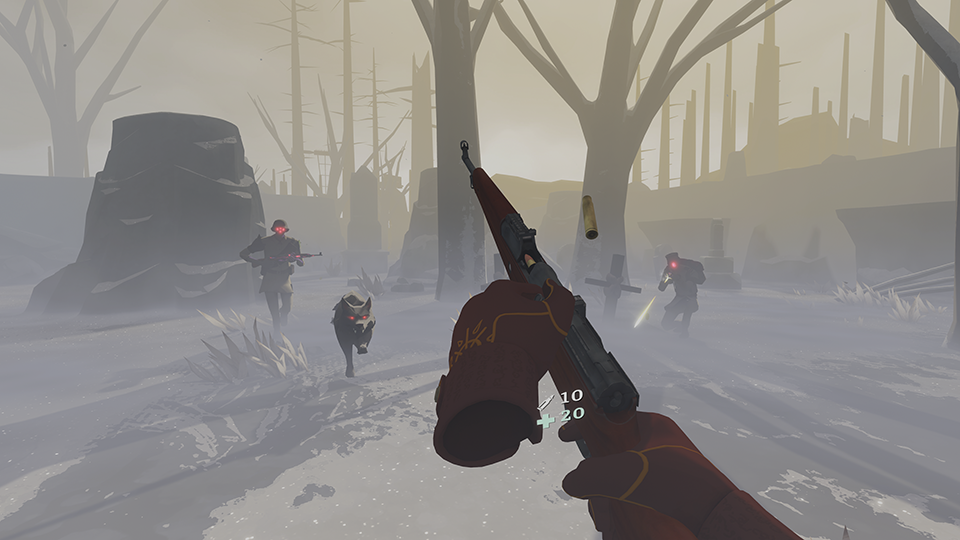
It’s very easy to get overwhelmed if you aren’t careful.
This brings me to my final thoughts and review score. I love Roguelikes, Roguelites, soul- likes and anything in between. They are video game crack to me, as I love the increased difficulty and the addictive game loop. When looking to VR we have had a few gems in the form of Compound, In Death, Cosmodread and The Persistence. I would add The Light Brigade in that short list as it offers a very addicting and memorable experience that is only slightly held back by some irritating control mechanics which I hope are patched after further community feedback. Regardless, it’s still a first rate time in VR.
Looking to the rapidly approaching PSVR 2 launch, for many The Light Brigade is a possible launch day purchase, and while it may get lost in the mix with the likes of some of the more marquee titles. If it can get some of those rougher game mechanics worked out before launch it may be the surprise launch title that keeps players away from some of the bigger AAA titles.
Funktronic Labs provided a press code for this title and, regardless of this review, we thank them for that!
